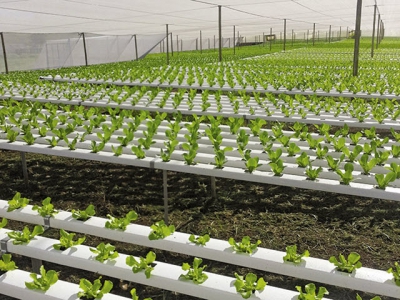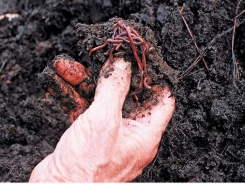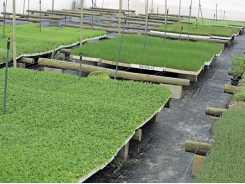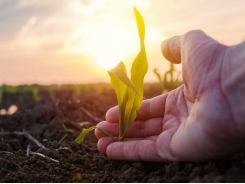Greenhouse production in SA – learning from Europe

It is every vegetable farmer’s dream to produce a higher yield per hectare and have the same yield winter and summer. Jacques Claassen visited an innovative lettuce producer achieving exactly that in Gauteng’s Tarlton area.
Greenhouse production in South Africa is 50 years behind that seen in Europe and some countries elsewhere. This is according to Johan van den Bosch, a Dutch immigrant who grew up in South Africa and is leading the country’s greenhouse production.
Greenhouse production in South Africa
Situated on 25ha in Tarlton, Gauteng, his Jomajoco farming enterprise produces a range of lettuce, as well as herbs, on 15,5ha. The operation, which Johan runs with his wife Marinda, is one of 96 participants in the Woolworths Farming for the Future programme. Woolworths is Jomajoco’s biggest client, but the operation also supplies Spar and Pick n Pay outlets.
The table system
After Johan studied greenhouse production systems in the Netherlands, other European countries and Australia, he expanded Jomajoco’s open-field and tunnel production two years ago by growing lettuce in custom-made gutters under shade-cloth.
These were assembled in an area of 5ha to resemble a system of ‘tables’, as he refers to them. Johan designed them himself and provided the specifications to the manufacturer, Theo’s Metals.
A lettuce-growing table consists of a hip-high steel framework carrying six gutters horizontally next to one another, with comfortable working spaces in between. The height of the tables allows the workers to harvest the lettuce standing up rather than bending over the ground. It also prevents soil from getting onto the lettuce.
The height also proved to have another advantage during floods in Gauteng earlier this year: flood water ran half-a-metre deep underneath the tables without affecting the crop.
Each gutter contains equally spaced holes. Solid growing substrate blocks (4cm x 4cm x 4cm) of black and white peat are placed in these, allowing the seedlings to grow in a substrate. The roots of the plants quickly grow through the growing blocks to reach the irrigation water and fertiliser in the gutters underneath. Because the greenhouse is erected on slightly sloping terrain, gravity ensures that the water easily runs through the gutters.
Water use
Jomajoco is geared for optimal water use, wasting as little as possible. The table and gutter system ensures that, unlike in conventional production systems, water does not soak away into the ground. Moreover, the greenhouse is fitted with an iSii process computer from Dutch company Hoogendoorn that controls irrigation management and ensures that water that is not absorbed is collected, disinfected and reused.
Thanks to this recirculation and the fact that water is supplied according to the needs of the plants, Jomajoco has been able to achieve a considerable increase in yield while using 30% less water than on open fields. The farm uses high-quality borehole water.
Johan nevertheless sends water samples to the Netherlands every fortnight for analysis. The results are available within two days and a consultant in Belgium makes recommendations on optimising the fertiliser in the greenhouse.
“The pH of the water should be 6 and its EC (electrical conductivity) should be 2,” Johan explains. “The fertiliser recommendations from our consultant are very scientific. We picked up information that we had never known about. But it actually boils down to this: the stronger and healthier the lettuce plants, the less fertiliser is required.”
Moreover, by using Dutch company Bosman Van Zaal’s patented irrigation unit, the Cyclone, carbonates can be removed from the water to deliver a better mix of water and fertiliser. This reduces fertiliser use by at least 10%. Shade-cloth prevents potential hail damage in summer, and enables Jomajoco to grow lettuce all year round without the inputs of open-field production – crop rotation, tractors, rippers and ploughs.
Johan points out that he is still learning about the table production system, so he is still also producing in tunnels on 4,4ha and on 6ha open fields, where he grows lettuce from November to April. But he is doubtful that he will continue with open-field farming indefinitely.
His greenhouse system ensures a 43% higher planting density than on open fields. Johan adds that a successful open-field lettuce producer can expect a yield of 60% to 70% (seedling survival to harvest), whereas a similar producer using gutters can expect a yield of 90% to 95%. With planting density and yield potential taken into account, a producer can achieve the same iceberg lettuce yield on 3ha of gutters as on 10ha of open fields.
Power use
Although Johan increased his production threefold with the table and gutter system, his electricity bill increased by a relatively small amount – from R3 500 per month to R4 500. Having seen advanced greenhouse operations in the Netherlands, he called in the help of an electrician to install a speed drive device on his 22kW borehole pump. It ensures that the pump runs at only 31A instead of 41A when started up. This device saves him R10 000 per month. Given its cost of R40 000, it was paid for in just four months.
In addition to Jomajoco, Johan runs an iceberg lettuce farming operation with two partners, Gloria Ramahlodi, a food technologist, and Steve Silverman, a distributor. He has set aside 3ha of the 5ha table system for this crop.
Advanced technology
In an effort to take sustainable greenhouse production even further, Johan signed a co-operation agreement with a group of Dutch horticultural suppliers on 7 July. This ceremony took place in the Jomajoco shade-cloth greenhouse during the visit of a Dutch trade delegation to South Africa, facilitated by the Embassy of the Kingdom of the Netherlands in Pretoria. The delegation was led by the Dutch minister for foreign trade and development, Lilianne Ploumen.
The agreement was signed to introduce advanced technology, adapted to local conditions, on Johan’s farm, which will be used as a training centre for other farmers to ensure that South Africa takes advantage of this agricultural technology. “Every crop poses a food security challenge and the aim of our agreement is to enable SA farmers to produce more with less – in other words, to achieve higher yield per hectare with less water, less fertilisers and less energy,” says Johan.
Jomajoco and its Dutch partners stress that the costs of labour and energy as well as limited clean irrigation water are forcing the local horticulture sector towards more intensive production. Nevertheless, Johan points out that there is a fine line in South Africa between job creation and automation. He employs 120 full-time workers.
Farming for the future
Also attending the ceremony was Sybrand Fourie, a procurement specialist for Woolworths. He says it became clear some time ago that South Africa required a new approach to farming which could address the above-mentioned problems. “In response, we began developing the Farming for the Future method five years ago, based on international best practice, and we believe it’s one of the most comprehensive farming models globally.”
Woolworths sources 95% of its fresh produce locally and the rest from other African countries. “But we prefer local fresh produce,” Fourie stresses. South Africa remains the Netherlands’ main African trading partner. The Netherlands in turn is the second-largest investor in South Africa and the eighth-largest trading partner worldwide.
Related news
Tools

Phối trộn thức ăn chăn nuôi

Pha dung dịch thủy canh

Định mức cho tôm ăn

Phối trộn phân bón NPK

Xác định tỷ lệ tôm sống

Chuyển đổi đơn vị phân bón

Xác định công suất sục khí

Chuyển đổi đơn vị tôm

Tính diện tích nhà kính

Tính thể tích ao




 Growing Strawberry Plants – How to Grow Strawberry…
Growing Strawberry Plants – How to Grow Strawberry…  Study addresses key challenges in expanding the supply…
Study addresses key challenges in expanding the supply…